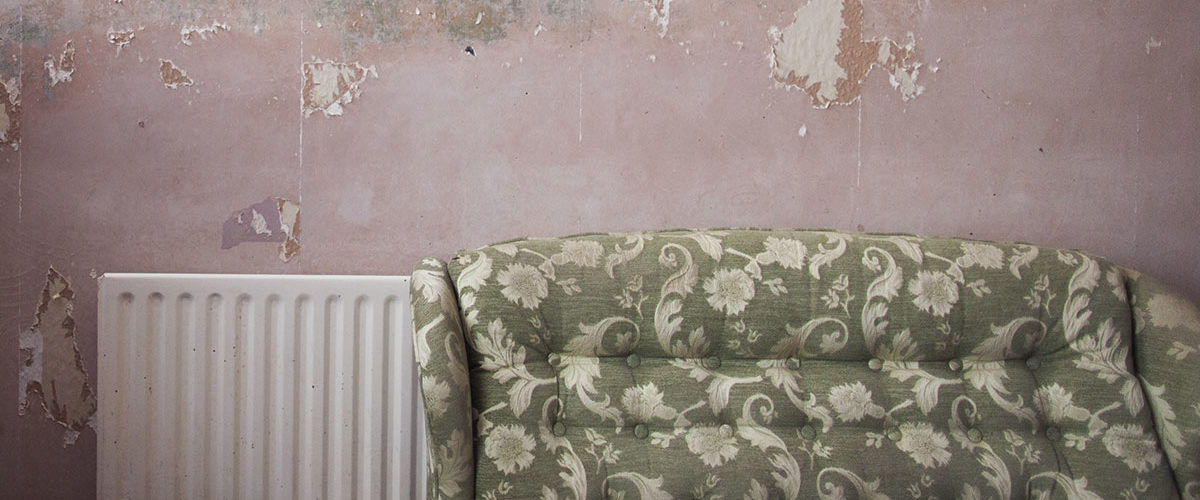This blog post explains the warning signs of disrepair to look out for in your home.
It’s important to know these and make your landlord aware of any issues, as soon as possible. We’re here to help if you need a hand writing your landlord a letter requesting repairs.
Damp
If you’re worried that damp could be a problem in your home, there are some common signs that you can keep an eye out for. Damp will not go away on its own and can seriously impact your health if left to its own devices, so it’s vital to report anything you spot to your landlord immediately.
Damp and mould are caused by excess moisture in the home.
Common signs of damp:
- A damp and musty smell
- What looks like mould or mildew on walls, floors or ceilings
- Walls, floors or ceilings that feel cold or damp
- Dark or discoloured patches on walls or plaster
- Excessive condensation on windows
- Your wallpaper lifting or peeling
Rising damp is caused by ground level water moving up through a wall or floor.
Common signs of rising damp:
- Damp patches on a wall that start at the floor and gradually move upwards to the ceiling
- What looks like a white, powdery salt-like substance on a wall
- Flooring such as tiles, vinyl or carpet, that are wet and lifting
- Yellow or brown staining on a wall that look like tide marks
- Skirting boards or plaster that is damp or rotting
Hot Water Issues
There’s nothing worse than your heating deciding to not work properly, right as it starts getting cold outside. That’s why it’s so important to look out for the signs that there could be a problem looming. If you have any concerns, please contact your landlord, who can contact the appropriate professional to tackle the problem.
Your central heating boiler uses water, moved by an electrically powered pump, to carry heat into radiators in all the other rooms of your home.
Signs your central heating boiler is dangerous:
- Black stains on or near your boiler could indicate a dangerous carbon monoxide leak
- A faint, strange smell which could indicate a dangerous carbon monoxide leak
- Your combi boiler pilot light frequently changes from blue to yellow
- Your combi boiler pilot light frequently blows out
Signs your radiators are failing to heat your home properly:
- Your radiator is hot at the bottom but cold at the top
- Your radiator is hot at the top but cold at the bottom
- No radiators in your home are working at all
- A lone radiator is cold or not working
- A lukewarm radiator
Your water heater is a device for heating up water in your home. It uses either a gas or electric heating element to heat and store water at a set temperature.
Signs that your water heater is failing:
- Water from your hot water tap coming out as brown or rust-colored
- A leak coming from or around your water heater
- A water heater that’s more than 10 years old
- A rumbling or noisy water heater
Dodgy electrics
Most electrical fires are caused by faulty electrical outlets and old, outdated appliances. Faulty or bad wiring in your home can have fatal consequences. Keep an eye out for these warning signs and always contact your landlord who can arrange repairs to be made for you. For health and safety reasons, please don’t ever try and tackle an electrical problem yourself.
Signs your home may have electrical problems:
- Circuit breakers that trip and turn off automatically regularly
- Sparking coming from your circuit breaker or fuse box
- Buzzing, charred or discoloured outlets and switches
- Frayed, damaged and exposed wires and cables
- Burning smell or odour coming from your outlet
- Frequently flicking or dimming lights
- Shocking switches and outlets
Infestations
Ideally, it is best to look all over your house on a regular basis to make sure you don’t miss any signs of pesky unwanted house guests. Pests can enter your home in pipes, gaps in walls and other entry points, and will for one purpose: reproduction. If you have any concerns that your home may be infested, please contact your landlord as soon as possible. Here’s some signs to help you keep the bugs at bay.
Infestations are flurries of common household pests that have a history of living, invading, causing damage, eating human foods, which include mice, bed bugs and moths.
Where to look for signs of an infestation:
- Rooms that aren’t often occupied, such as laundry rooms, utility rooms, basements and attics
- Anywhere that you have links to the outside such as pipes or ground level windows
- Anywhere that you have appliances
- Your kitchen
- Your garage
Warning signs of an impending pest infestation:
- Pitter patter noise – easiest to hear at night – movement in wall cavities / attic / crawl space
- Musky smell, similar to a pet rabbit’s hutch that hasn’t been cleaned for a while
- Nesting in darker, less visited parts of your home – e.g. behind appliances, in wall cavities or within loft insulation
- Damaged furniture and wiring – e.g. gnawed chair leg could indicate mice
- Droppings – mice leave larger dropping, whereas cockroach droppings look like coffee granules
For more help and advice on what disrepair you’re responsible for, how to request repairs from your landlord and what repairs you can safely do yourself please take a look at the advice pages on our website, chat to us, or give us a call.


